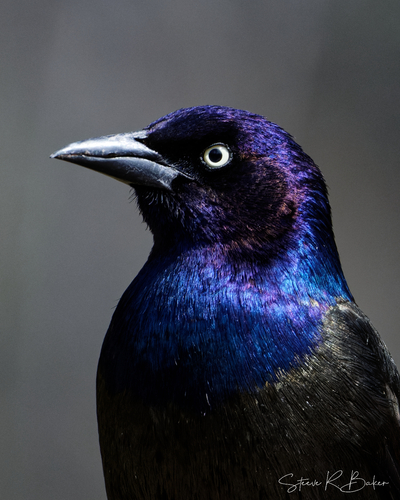
Common Grackle
The Common Grackle (Quiscalus quiscula) is a large, iridescent blackbird native to North America. Often found in large, noisy flocks, they are highly adaptable birds, thriving in both rural and urban environments. They play a significant ecological role as both seed dispersers and consumers of insects, although their large numbers can sometimes lead to conflict with agricultural interests. While not typically considered a bird of significant cultural importance, their ubiquity and bold behavior have made them a familiar sight to many.
28-34 cm
Length
36-46 cm
Wingspan
Least Concern
Conservation Status
Distribution
Common Grackles are found throughout North America, east of the Rocky Mountains. Their range extends from southern Canada down to Florida and the Gulf Coast, and westward to the Great Plains. Some populations are migratory, with northern birds moving south for the winter, while others are resident year-round.
Lifespan
Up to 22 years in the wild (based on banding records), but most live much shorter lives.
Common Grackle's Habitat
Habitat Types
Agricultural fields, Open woodlands, Marshes, Urban parks, Suburban areas
Climate Zones
Temperate, Subtropical
Adaptations
Common Grackles are highly adaptable to a variety of habitats. Their broad diet allows them to thrive in different environments. Their strong legs and feet are well-suited for walking and foraging on the ground.
Variations
Three subspecies are generally recognized: the Purple Grackle (Q. q. quiscula) in the southeast, the Bronzed Grackle (Q. q. versicolor) in the interior, and the Florida Grackle (Q. q. stonei) in Florida. These differ primarily in the color of their iridescence.
Appearance
Breeding Plumage
Adult plumage is largely consistent year-round, but may appear duller in the non-breeding season.
Seasonal Feather Changes
The intensity and color of iridescence can vary slightly with wear and molt.
Sex Based Plumage Differences
Males have a more intense, glossy iridescence than females, which can appear duller and browner.
Notable Features
Long, keel-shaped tail, Glossy, iridescent black plumage, Bright yellow eyes, Long, pointed bill
Diet and Feeding
Primary Foods
Seeds, Grains, Insects, Small invertebrates, Occasionally small vertebrates (e.g., frogs, fish)
Foraging Behavior
Common Grackles forage primarily on the ground, walking or hopping while searching for food. They also glean insects from vegetation and sometimes wade in shallow water. They are known to follow plows to catch exposed insects and grubs.
Specializations
Their strong bill allows them to crack open seeds and nuts. They also have a specialized tongue that helps them extract kernels from corn.
Seasonal Diet Variations
Their diet shifts with the seasons. Insects are more prevalent in the diet during the breeding season, while seeds and grains are more important in the fall and winter.
Behavior
Social Structure
Highly social birds, often forming large flocks outside of the breeding season. Breeding colonies can range from a few pairs to hundreds of nests.
Communication
A variety of harsh calls and squeaks, A distinctive 'rusty hinge' song, Visual displays, such as bill-pointing and wing-spreading
Migration
Northern populations are migratory, moving south in large flocks in the fall and returning in the spring. Southern populations are often resident.
Territorial or Group Behaviors
During the breeding season, males defend small territories around their nests. Outside of the breeding season, they are highly gregarious and form large foraging and roosting flocks.
Conservation
Threats
Habitat loss (although they are adaptable), Pesticide use (indirectly through insect prey), Persecution by humans (due to perceived agricultural damage)
Protection Programs
Migratory Bird Treaty Act (protects them from direct harm in the US), General wildlife conservation efforts that protect habitat
Local National Laws
Protected under the Migratory Bird Treaty Act in the United States.
Population Trend
Stable
Population Estimates
Estimated at around 73 million individuals.
Interesting Facts
Grackles sometimes practice 'anting'
They rub ants on their feathers, possibly to soothe skin irritation or remove parasites. The formic acid from the ants may act as an insecticide or fungicide.
They can mimic the calls of other birds
Although not as skilled as mockingbirds, they have been observed imitating other species.
Grackles are known to dip hard food items in water.
This behavior, called 'dunking,' softens the food and makes it easier to digest. This is common with dog food, bread and other dry items.
Their eyes change color as they mature.
Juvenile Common Grackles have dark brown eyes, which transition to the bright yellow of adults.
Faqs about Common Grackle
Why are there so many grackles in my yard?
Grackles are attracted to readily available food sources, such as bird feeders, spilled grain, and insects in lawns. Their large flocks can make them seem especially numerous.
Are grackles harmful to other birds?
While they can sometimes outcompete other birds at feeders, grackles are not typically considered major threats to other bird populations. They may occasionally prey on the eggs or nestlings of other birds, but this is not a primary food source.
Do grackles damage crops?
Grackles can damage crops, particularly corn, rice, and sunflowers. However, the extent of their damage is often debated, and they also consume large numbers of insects that are considered agricultural pests.
What should I do if a grackle is nesting near my house?
It is best to leave the nest alone. Common Grackles, their nests, and eggs are protected under the Migratory Bird Treaty Act, making it illegal to harm or disturb them without a permit. If you need to deter them, focus on removing food sources and using deterrents like visual scare devices *before* nesting begins.
Copyright @ Nature Style Limited. All Rights Reserved.
 English
English